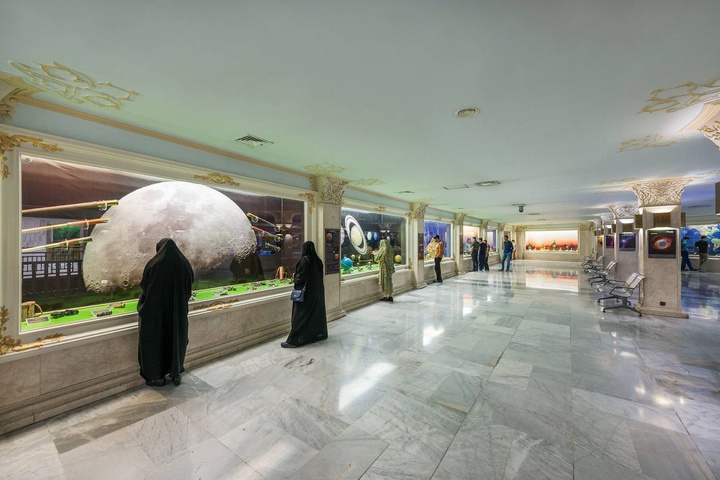Astronomy Repository is one of the 18 specialized treasuries of Astan Quds Razavi Museum, which welcomes lovers of history of astronomy as the first science and technology museum in Iran.
Abdolhossein Malek Jafarian, head of the Repository Department of Astan Quds Razavi Museum in an interview talked about this repository and its valuable works:
Please introduce the history and artifacts of the Astronomy Repository of Astan Quds Razavi.
This repository was inaugurated on July 8, 1999, on the second floor of Razavi Museum located in Kowsar Courtyard of Imam Reza shrine. Those interested in history, art, and science can visit 110 exquisite artifacts displayed in this repository every day from 8:00 to 17:45. These precious objects include various types of refracting and reflecting telescopes, various types of astrolabes, various types of compasses and Qibla finders, celestial and geographical globes, binoculars and monocular, opera glasses, theodolites, sextants, various models of earth, moon, and sun movement, armillary spheres, and more.
Which prominent figures played a role in collecting works in Astronomy Repository?
Many of the works in this repository were endowed to Astan Quds Razavi by late Dr. Seyyed Jalaladdin Tehrani. Some works were also donated to the museum of this holy shrine by other devotees of Imam Reza (AS), such as Dr. Farhad Rahimi, a physicist and the founder of physics centers in Iran.
What era does the oldest work in this repository belong to?
The oldest work in the Astronomy Repository is a spherical astrolabe from Safavid era, made of brass in 1058 AH by master "Ziauddin Muhammad ibn Qaim ibn Mulla Isa ibn Mulla al-Haddad al-Astrolabi Humayuni Lahori" and endowed to Astan Quds Razavi by Seyyed Jalaladdin Tehrani.
Please give some other examples of prominent works in this repository.
Astrolabe is one of the most fascinating tools that was used in the science of astronomy in the past. In fact, the use of astrolabe was very extensive and included various models. Astrolabes are divided into two general categories: "spherical" and "planar," both of which are displayed in this repository. In addition to the spherical astrolabe that was introduced, the brass planar astrolabe made by "Abdul-A'immeh" is also of particular value. We can also mention the Gregorian reflecting telescope, which was made of brass in Paris in late 18th century. Theodolites are also considered among the first surveying instruments used to determine the geographical position of the observer at different times. In this repository, valuable theodolites are on display, some of which are rare in terms of number of levels they have.
Also, various types of geographical and celestial globes are placed in a separate display case here. Celestial globes, too, are large hypothetical spheres with an infinite radius that encompass all celestial bodies, and their focal point is the center of the Earth or location of the observer (one looking at the sky). Some of the geographical and celestial globes displayed in this repository, with a history of 170 years, were made of cardboard and wood in England.
Given the importance and application of astronomy in navigation and the existence of objects and tools related to maritime sciences in the repository, a special display case has been dedicated to the storage and display of astronomical tools related to navigation in the middle of the Astronomy Repository hall as well.
What new works have been displayed in this repository during last year?
An observatory telescope built in 1881 by "Howard Grubb" in Dublin, is among the new works displayed in the repository of. This refracting telescope includes two optical tubes and a dark chamber for photographing celestial events. It might be interesting for you to know that the partial solar eclipse on January 6, 1961 in Tehran, was observed by this telescope.
How do visitors to Razavi Museum view works in the Astronomy Repository?
Works in this repository are important factors in recognizing the industrial and modern identity of societies. Therefore, paying attention to the history of science in the repository is an interesting and commendable action for visitors, especially young generation. In this regard, observing various types of telescopes, astrolabes, and cameras is very attractive for visitors.


Your Comment